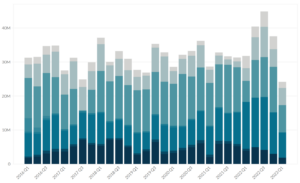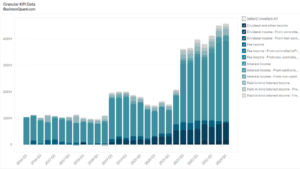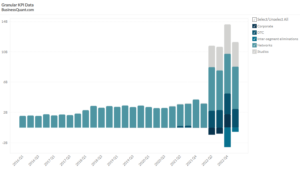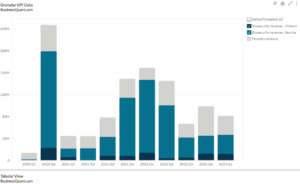
LendingClub Corp’s HFI Loans (2020-2023)
Exclusive Data
You need the Pro Plan to access KPI data
- Full access to the platform
- KPI data & segment financials on US stocks
- Financial data on thousands of stocks
- Download data in xlsx and csv formats
Pro Plan
$49 per month*
60% discount ends in:
.
About
More information
Subscribe to Pro or Enterprise plans to unlock this feature.
Contact the Analyst
Subscribe to Pro or Enterprise plans to unlock this feature.
Become a smarter investor today.
Access KPIs & Segment Financials on US stocks
This statistics highlight LendingClub Corp’s HFI Loans, reported on a quarterly basis from Q1 2020 onwards.
LendingClub Corp’s HFI Loans
The HFI loans of LendingClub Corporation has been growing over the years. The HFI loans in the third quarter of 2022 increased by 17.26% compared to the second quarter of 2022. In the fourth quarter of 2022, the HFI loans increased by 19.83% from the third quarter of 2022. The company has witnessed a growth of 14.72% in the HFI loans from the fourth quarter of 2022 to the first quarter of 2023.
| Period | HFI Loans in USD |
| 2022 Q2 | 3,77,10,00,000 |
| 2022 Q3 | 4,42,20,00,000 |
| 2022 Q4 | 5,29,90,00,000 |
| 2023 Q1 | 6,07,90,00,000 |
HFI Loans
HFI loans, also known as Held for Investment loans, are loans that a financial institution retains on its books with the goal of collecting contractual cash flows over the period of the loan. These debts are normally retained until maturity or until the borrower pays them off.
HFI loans are loans made available to borrowers by banks and other lending organizations for a variety of purposes, including personal loans, mortgages, business loans, and any other sort of loan. When a loan is designated as HFI, it signifies that the financial institution intends to keep it as an investment rather than sell it on the secondary market.
A bank gets interest from the borrower when it offers an HFI loan. When a bank makes an HFI loan, the interest revenue generated by the borrower’s payments is recorded as an asset on the bank’s balance sheet. The bank will also bear the loan’s related credit risk, which includes the risk of default or nonpayment by the borrower.
Moreover, HFI loans differ from loans categorized as Held for Sale (HFS). Loans held for sale are those that a financial institution expects to sell in the near future. These loans are documented on the balance sheet at fair value and are normally reported separately from HFI loans. Overall, HFI loans are an essential part of a financial institution’s portfolio.
The allowance for loan and lease losses (ALLL) on HFI loans and leases at amortised cost for lifetime expected losses under CECL (Current Expected Credit Losses) is first recognised as a “Provision for credit losses” at the time of origination. The provision for credit losses was $70.6 million in the first quarter of 2023 and $61.5 million in the fourth quarter of 2022, representing a 15% increase.
Certain loans and leases held for investment (HFI) are reported at amortized cost, whilst certain HFI and all held for-sale (HFS) loans are recorded at fair value due to the Company’s use of the fair value option. Loans HFI at LC Bank are largely supported by its deposit base. Over the length of the loan, the majority of HFI loans are fixed-rate securities.
About LendingClub Corporation
LendingClub is the top digital marketplace bank in the United States. The company was created in 2006, and it used technology, data science, and a new marketplace model to bring a conventional credit product – the installment loan – into the digital age. As a result, it has grown to become one of the leading suppliers of unsecured personal loans in the United States. It runs the vast bulk of its operations business through LC Bank, as a lender and originator of loans and as a regulated bank in the United States.
Did you like LendingClub Corp’s HFI Loans statistic?
Access more such KPI data points and segment financials on thousands of US stocks, with Business Quant.
You can get started here.
More data on US Stocks

Our Plans
Always know what you’ll pay. No hidden costs or surprises.
- Annual
- Monthly
60% discount till April 30
Pro
For serious investing
-
Company KPI data Access segment financials, non-GAAP metrics and KPI data from presentations and filings. Examples include financials by segment / region / product category, AT&T's broadband subscriber trends, Tesla's deliveries by model and lots more.
-
Stock research tools Features include : stock screener, stock comparison, industry financials, stock warnings, advanced charting tools, timeseries tables, scatter charts, financial statements, stock reports, SEC filings, stock ratings, institutional and insider ownership data. There are 200+ financial items and ratios on thousands of US stocks.
-
Industry data & tools Access premium operating data on 40+ industries. Examples include market share, smartphone shipments by vendor, subscribers by wireless carrier, historical gold production. There are 20,000+ such statistics.
Enterprise
For tailored workflows
-
All of Pro plan Get unfettered access to all our dashboards and dossiers.
-
Custom built features Get tailored dashboards built specially for you , based on your set of requirements, to simplify your research workflow.
-
Admin billing Back-end documentation support and multi-seat licensing.
* Billed annually, local taxes extra.
60% discount on Annual plan
Pro
For serious investing
-
Company KPI data Access segment financials, non-GAAP metrics and KPI data from presentations and filings. Examples include financials by segment / region / product category, AT&T's broadband subscriber trends, Tesla's deliveries by model and lots more.
-
Stock research tools Features include : stock screener, stock comparison, industry financials, stock warnings, advanced charting tools, timeseries tables, scatter charts, financial statements, stock reports, SEC filings, stock ratings, institutional and insider ownership data. There are 200+ financial items and ratios on thousands of US stocks.
-
Industry data & tools Access premium operating data on 40+ industries. Examples include market share, smartphone shipments by vendor, subscribers by wireless carrier, historical gold production. There are 20,000+ such statistics.
Enterprise
For tailored workflows
-
All of Pro plan Get unfettered access to all our features.
-
Custom built features Get tailored dashboards built specially for you , based on your set of requirements, to simplify your research workflow.
-
Admin billing Back-end documentation support and multi-seat licensing.
* Local taxes extra.






